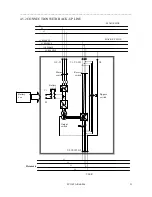
________________________________________________________________________________
EVO STAR 60-800
11
3
GENERAL DESCRIPTION
3.1
OPERATING PRINCIPAL
The U.P.S. is a continuous double conversion system with an output transformer. It works by carrying out a
continuous double conversion of the main supply, guaranteeing a constant stabilized supply of both voltage and
frequency, maintaining charge and control of the batteries (On-line functioning). In order to guarantee continuous
supply when the voltage of the electric system are no longer correct, power is drawn from the batteries. The system is
supplied complete with an automatic static commutator that connects the output to the back-up power supply, or if there
are special alarms such as the E.P.O. (Emergency Power Off) it shuts down completely output voltage.
3.2
DESCRIPTION AND PARTS
During normal functioning (figura 3.1) the system takes power from the mains by means of the input terminal (1).
The voltage goes through the disconnecting switch (4) and the fuse board (6/a ) in order to reach the rectifier module
(7), exiting which is a continuous controlled voltage available to charge or maintain battery efficiency (cross fuse (6/b)
and battery switch (8)) and to the inverter input (10). This step is to generate a three-phase voltage, stabilized and
synchronized with the back-up voltage. The static commutator (11) selects the power source to power the load, usually
on inverter (10). If there is an increase of output current or with specific alarms, the device (11) will commutate to the
emergency supply maintaining output continuity. If transferring takes place, output continuity is allowed by the
synchronism of the voltages generated with the emergency voltage. If asynchronous commutation should take place
there will be a power “dip” for maximum 20 ms.
When the power supply is not in the set parameters, the equipment maintains output voltage by taking power from
the batteries (9). The system is provided with a current control that keeps the current inside set parameters in the event
of current overloaded.
4
3
2
5
6/a
7
6/b
1
10
8
9
11
12
13
Back-up line
By-pass Line
1.
Power supply
2.
Manual By-pass
3.
Back-up line switch
4.
Mains switch
5.
Back-up fuses board
6.
Fuses board
a) Mains b)Battery
7.
Rectifier
8.
Battery switch
9.
Inverter
10.
Static switch
11.
Output switch
12.
Output
Picture 3.1
1/A
RECT
.
INV.
M.B.
I.B.
BAT
T.













































